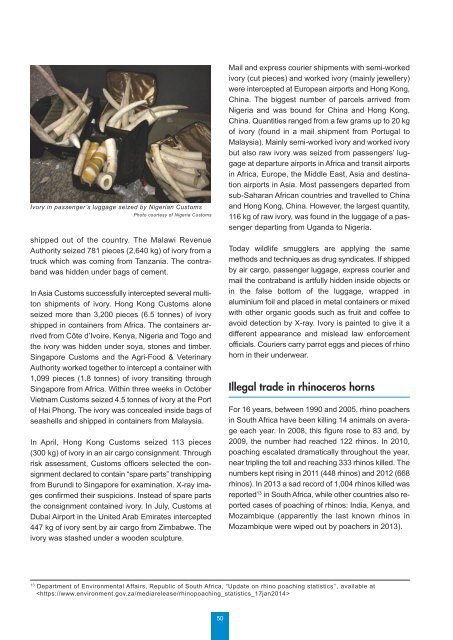Create successful ePaper yourself
Turn your PDF publications into a flip-book with our unique Google optimized e-Paper software.
Ivory in passenger’s luggage seized by Nigerian Customs<br />
Photo courtesy of Nigeria Customs<br />
shipped out of the country. The Malawi Revenue<br />
Authority seized 781 pieces (2,640 kg) of ivory from a<br />
truck which was coming from Tanzania. The contraband<br />
was hidden under bags of cement.<br />
In Asia Customs successfully intercepted several multiton<br />
shipments of ivory. Hong Kong Customs alone<br />
seized more than 3,200 pieces (6.5 tonnes) of ivory<br />
shipped in containers from Africa. The containers arrived<br />
from Côte d’Ivoire, Kenya, Nigeria and Togo and<br />
the ivory was hidden under soya, stones and timber.<br />
Singapore Customs and the Agri-Food & Veterinary<br />
Authority worked together to intercept a container with<br />
1,099 pieces (1.8 tonnes) of ivory transiting through<br />
Singapore from Africa. Within three weeks in October<br />
Vietnam Customs seized 4.5 tonnes of ivory at the Port<br />
of Hai Phong. The ivory was concealed inside bags of<br />
seashells and shipped in containers from Malaysia.<br />
In April, Hong Kong Customs seized 113 pieces<br />
(300 kg) of ivory in an air cargo consignment. Through<br />
risk assessment, Customs officers selected the consignment<br />
declared to contain “spare parts” transhipping<br />
from Burundi to Singapore for examination. X-ray images<br />
confirmed their suspicions. Instead of spare parts<br />
the consignment contained ivory. In July, Customs at<br />
Dubai Airport in the United Arab Emirates intercepted<br />
447 kg of ivory sent by air cargo from Zimbabwe. The<br />
ivory was stashed under a wooden sculpture.<br />
Mail and express courier shipments with semi-worked<br />
ivory (cut pieces) and worked ivory (mainly jewellery)<br />
were intercepted at European airports and Hong Kong,<br />
China. The biggest number of parcels arrived from<br />
Nigeria and was bound for China and Hong Kong,<br />
China. Quantities ranged from a few grams up to 20 kg<br />
of ivory (found in a mail shipment from Portugal to<br />
Malaysia). Mainly semi-worked ivory and worked ivory<br />
but also raw ivory was seized from passengers’ luggage<br />
at departure airports in Africa and transit airports<br />
in Africa, Europe, the Middle East, Asia and destination<br />
airports in Asia. Most passengers departed from<br />
sub-Saharan African countries and travelled to China<br />
and Hong Kong, China. However, the largest quantity,<br />
116 kg of raw ivory, was found in the luggage of a passenger<br />
departing from Uganda to Nigeria.<br />
Today wildlife smugglers are applying the same<br />
methods and techniques as drug syndicates. If shipped<br />
by air cargo, passenger luggage, express courier and<br />
mail the contraband is artfully hidden inside objects or<br />
in the false bottom of the luggage, wrapped in<br />
aluminium foil and placed in metal containers or mixed<br />
with other organic goods such as fruit and coffee to<br />
avoid detection by X-ray. Ivory is painted to give it a<br />
different appearance and mislead law enforcement<br />
officials. Couriers carry parrot eggs and pieces of rhino<br />
horn in their underwear.<br />
Illegal <strong>trade</strong> in rhinoceros horns<br />
For 16 years, between 1990 and 2005, rhino poachers<br />
in South Africa have been killing 14 animals on average<br />
each year. In 2008, this figure rose to 83 and, by<br />
2009, the number had reached 122 rhinos. In 2010,<br />
poaching escalated dramatically throughout the year,<br />
near tripling the toll and reaching 333 rhinos killed. The<br />
numbers kept rising in 2011 (448 rhinos) and 2012 (668<br />
rhinos). In <strong>2013</strong> a sad record of 1,004 rhinos killed was<br />
reported 13 in South Africa, while other countries also reported<br />
cases of poaching of rhinos: India, Kenya, and<br />
Mozambique (apparently the last known rhinos in<br />
Mozambique were wiped out by poachers in <strong>2013</strong>).<br />
13<br />
Department of Environmental Affairs, Republic of South Africa, “Update on rhino poaching statistics’’, available at<br />
<br />
50




